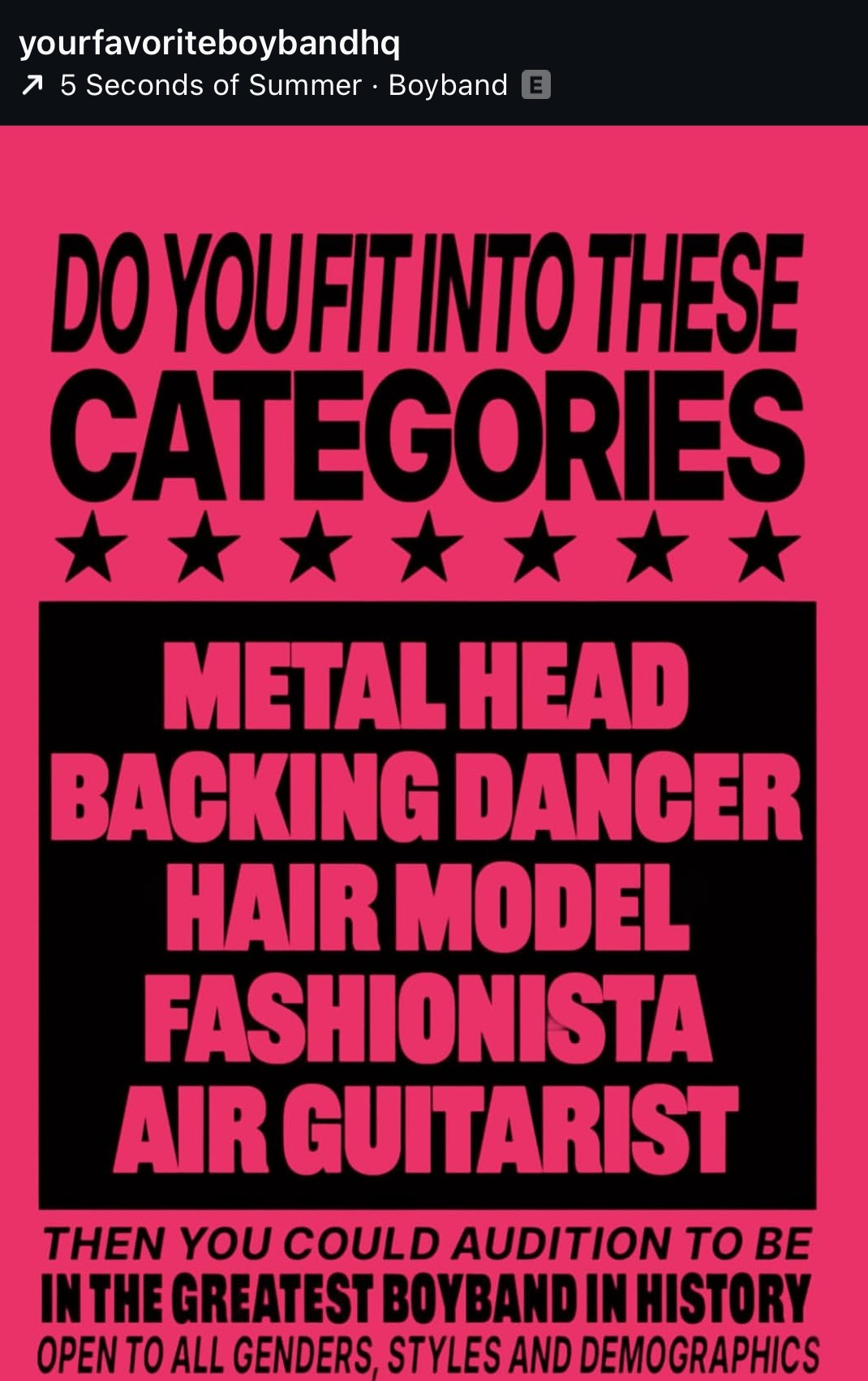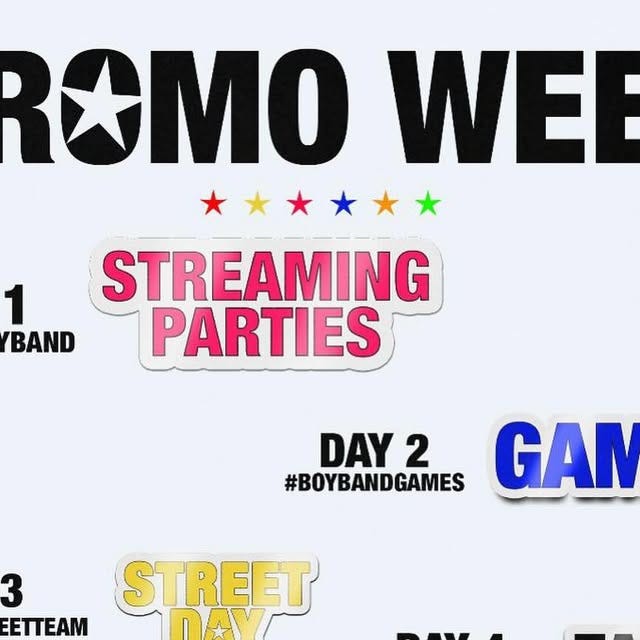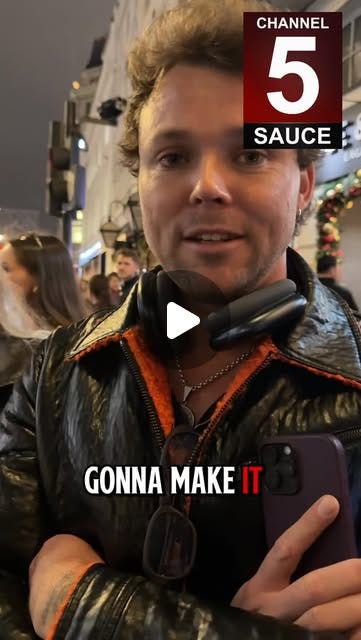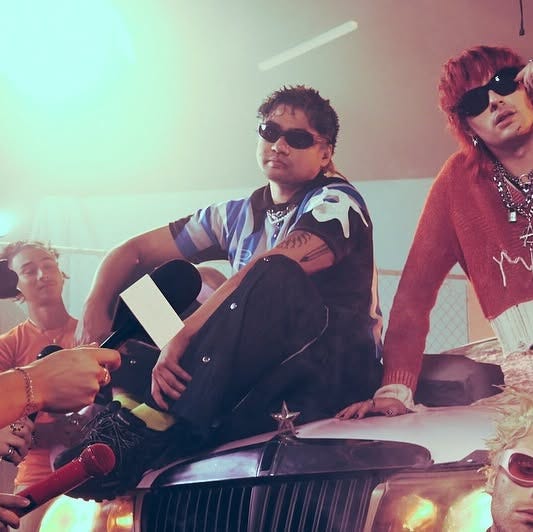Boyband Gone Rogue: How 5SOS Built Their Most Unhinged Era Yet
A deep dive into the rollout of "the greatest album of all time - until the next one."
Everyone’s a Star!, the sixth studio album from Australian group 5 Seconds of Summer, is officially out now. Originally announced in September, the two-month wait to hear the project somehow didn’t feel long, thanks to one of the most creative, fan-driven rollouts the band has ever done.
As a longtime fan of 5SOS, I can’t lie and say the band hasn’t always been inventive with their marketing. I still remember being fourteen, watching a mysterious figure spray paint a wall for hours, just to reveal a new single, for example.
But this time, their creativity felt different. It went beyond manufactured hype, and became a sort of performance art. The comeback was loud, unhinged, deliberately ridiculous and very meta. It’s been impossible to ignore.
Overnight, the band wiped their Instagram and reemerged as a self-aware caricature of a boyband, with a rollout featuring cryptic posters, pink limos, fake press conferences, a life-size doll box, an entire ecosystem of absurdist promo accounts and “100% more ego.”
Of course, beneath all the jokes and neon colors, there was also something heavier — a story of grief, frustration and a blunt critique of the music industry machine they grew up inside.
The entire rollout reveals how a band turned their history into commentary, and how a fandom responded by making the era feel more collaborative, creative and connected than ever.
Your Favorite Boy Band Is Back
When 5SOS wrapped The 5 Seconds of Summer Show in October 2023, most fans assumed they wouldn’t see the group for a while. The world tour felt like a celebration of the band’s 10th anniversary, with a setlist that was a perfectly curated mix of hits from every era and fan-selected deep cuts that changed nightly. It had the energy of a finale, even if no one said the word. Then, the band went away for a bit.
To many fans, “hiatus” is a dirty word. Usually, if a musical group says they’re taking one, it’s less of a “short break” and more of a nicer way to say it’s the end.
But 5SOS didn’t disappear with that kind of intention. After the tour, they stepped back so each member could experiment with their own sound, rest, grow their families and come back with a fresh creative perspective.
Of course, because each member dropped their own solo albums within the timespan, there was a misconception amongst the general public that the group had disbanded, granting them a unique opportunity to stage a flashy return from a “hiatus” they never actually announced.
It became clear very quickly that 5SOS was willing to commit to the bit.
In early September, cryptic posters popped up in cities around the world, proclaiming that “Your Favorite Boy Band Is Coming Back.” Those curious could log onto a website plugged on the posters, titled YourFavoriteBoyBand.com, where they could complete a quiz filled with boyband stereotypes to find out who their favorite boy band is. Not that they had a choice, however, because the only possible quiz response was that “Your favorite boyband is 5 Seconds of Summer.”
Is 5 Seconds of Summer even a boyband? I never saw them as such, due to the fact that they played their own instruments, carried a pop-punk sound and never truly tried to dance. For 5SOS, who entered the industry under the wings of One Direction and had an expansive fanbase of young teenage girls, it was a stereotypical label they disliked. Really, they’ve never been a boy band, but just boys…in a band. None of that matters now, however, as they’ve proudly reclaimed the label.
“For a long time we let it become a word that would offend us and I think as we got older, we found the idea of being called a boyband a good thing we were like oh man you know people have sort of stopped calling us a boyband, how can we make them do it again,” Michael Clifford said in an Official Charts interview. “We can be whatever we want. And if you want to use it as a dirty word, fine. But let’s make it benefit us and let’s make it do something for us and take power in the things that are sometimes thrown against you.”
Online, the 5SOS “boy band” universe expanded quickly. The group wiped their Instagram and returned with a carousel of images featuring messages that read like a group chat meltdown:
“5SOS are breaking up?? Click here for proof.” “This post was NOT approved by management.” “The label is NOT going to be happy about this.” “YOUR #1 OBSESSION.” “BITE THE APPLE BABY.”“5 SECONDS OF SUMMER IS NOT OK.”
Not long after, the group released a new single, “NOT OK,” before revealing Everyone’s A Star! would release on Nov. 14 in an album announcement video that featured a variety of fake tabloid headlines and self-referential jokes.
Around the same time, the group debuted a new Instagram account, @TheDailySauce, which felt like a parody of the Daily Mail’s tabloid headlines. Each video featured members of the band pretending to be reporters, doing mundane things or documenting their activities at different events in the album’s rollout.
”If this page disappears it’s because our manager found it,” the bio warned. It was ridiculous, but intentionally so.
Once the album was announced, the online chaos spilled into the real world.
With only a few hours’ notice, 5SOS invited fans to a free pop-up concert in West Hollywood. First come, first served. Fans sprinted down Sunset Boulevard, and right at 6 p.m., a baby pink limo pulled up to the Sun Rose’s courtyard.
The valet area had been transformed into a circular hot-pink stage stamped with a giant black star. Everyone who got inside wore matching t-shirts gifted to them, which of course read, “Your Favorite Boyband.”
At the center of all the commotion was their second single “Boyband.” The group launched a playful TikTok challenge framed as an audition to join “the greatest boyband in history.” The winner would receive a custom vinyl of the album, with their face on the cover.
Then came the fake-out of all fake-outs. They premiered what looked like the “Boyband” music video… only for it to be footage from mock press conference filled with questions like:
“Is it true you’re broke because of all your wardrobe?”
“Are you guys breaking up?”
“Name things you like about the other members.”
The plot twist was that there was no “Boyband,” music video after all. Instead, the video was an announcement for a global arena tour.
By late October, the rollout hit the band’s home country of Australia with a pair of exclusive, lottery-based fan events in Melbourne and Sydney. One was styled as an “OFFICIAL FAN PRESS CONFERENCE,” allowing fans to step into the world of the tour announcement video, while another included an album playback and Q&A.
In London, they unveiled a life-size “boy band in a box” display, essentially turning themselves into action figures, and to top it all off, the band celebrated a public induction into the Australian Walk of Fame.
But underneath it all, there was a deeper message.
Boyband Exploitation Core
What made this rollout feel especially layered is that the theatrics weren’t just for show. Beneath the neon colors, egotistical energy and parody accounts, the band was building a commentary about the environment they came up in, using humor to dissect an industry that often treats young artists as disposable.
The track “Boyband,” which the group referred to as “boyband exploitation core,” captures this tension clearly. Luke Hemmings shared that the song originally came from a darker emotional place, shaped partly by his grief after the death of Liam Payne. The timing of its release, on the anniversary of Payne’s passing, added another layer to how the band seemed to be processing what they had witnessed in the industry, both as former teenage artists and as peers of One Direction. The complicated emotions of losing someone who had lived through the same system they did, paired with the continuous circle of life they saw in up and coming artists inspired the song.
“It’s impossible not to get affected by it,” Hemmings said in a Rolling Stone interview. “All that anger and frustration, and sadness and grief, definitely plays a part in it.”
The lyrics point to different facets of that experience, including the scrutiny of their bodies, the dehumanizing demand to perform endlessly, the expectation to stay creatively predictable and the objectification that comes with being a public figure positioned as a commodity. None of these ideas are new to them, but presenting them through humor allowed the band to speak openly without the tone becoming heavy-handed.
Those emotions didn’t turn the rollout somber, but instead, they helped shape the absurdity into something worth meditating on.
Certain tactics took on a sharper edge when placed against this context. The music video fake-out, where the anticipated “Boyband” music video cut abruptly to a tightly staged mock press event, mirrored the experience of being constantly questioned about breakups, scandals and changes in image direction. The TikTok “audition challenge” poked at the idea of boybands as interchangeable archetypes, inviting fans to participate in a system the band knew was intentionally oversimplified. Showing up at fan events and performing in a massive doll box points to the commodification of music artists today, to be packaged and sold not just for their music, but for their image and ability to be personable to their audience.
The act of wiping their Instagram, only to re-emerge as hyper-stylized versions of themselves with overextended self-mythologizing (“THE GREATEST ALBUM OF ALL TIME — UNTIL THE NEXT ONE”), echoed the way public identity gets flattened and redefined in cycles, sometimes without the artists’ input.
While they hopped on the rising industry trend of having an official HQ account for the fans, @YourFavoriteBoybandHQ didn’t lean into the hyper-fandom tone that most label-run HQ accounts adopt. Instead of daily calls to action or parasocially loaded captions, the account felt intentionally sparse and distant. Everything was shared in threes to upkeep an aesthetic of minimal text, dry humor and visuals that fit the rollouts’s energy perfectly.
Because the band wasn’t manufacturing closeness or trying to imitate fan language, the real intimacy came from fans themselves, through their own networks, group chats, update accounts and street teams. The contrast between the deliberately distant HQ voice and the organic fan energy only strengthened the sense that the rollout was a collaboration, even if that collaboration wasn’t explicitly planned.
The choices become even more pointed when you consider the timing. Everyone’s a Star! is the band’s first album under Republic Records after a fully independent era. They returned to a major-label system at the exact moment they were satirizing the corporate structures that shaped their early careers. The doll-box display, the fake press conferences, the “manager doesn’t know about this” running joke — all of it played differently knowing they were once again navigating a label environment. It wasn’t a rejection of that system so much as a way of naming it, exaggerating it and leaving room for fans to understand the commentary embedded in the spectacle.
Together, these choices created an era that functioned as both satire and reflection. The band amplified pieces of the boyband experience to comment on the system that once defined them in a way that still felt playful, which made the critique easier for fans to absorb.
“Being in this long enough, and knowing our fan base long enough, we can talk about the ups and downs of not just ourselves as humans, but the course of our career,” Michael Clifford said in a Rolling Stone interview. “The part that I’m enjoying the most about it is touching on the irony of our real-life story, sort of exaggerated heavily into this fictional world that we can kind of create with the way that it looks and sounds.”
Instead of rejecting the boyband label, they leaned into it so aggressively that the parody became the point. It wasn’t an attempt to escape the word anymore, but to hollow it out and repurpose it for themselves. The result is a rollout that feels theatrical on the surface, but underneath it carries the weight of what they’ve lived through. Their self-awareness functioned less as self-deprecation and more as reclamation, and a way to rewrite their own mythology while acknowledging the strange, sometimes uncomfortable, always highly public world they came from.
Everyone’s a Star…Including the Fans
Though the world of Everyone’s a Star! was built by 5SOS, the fans certainly helped make it feel alive. Many of that momentum came from how quickly fans started documenting, decoding and amplifying every new piece of the rollout until it started to feel like everyone was building the era together.
A lot of that momentum came from the fan-run HQ pages that have existed long before this album cycle. While the band’s own HQ page maintained an intentionally distant, aesthetic-heavy tone, the grassroots HQ accounts continued doing what they’ve always done best — organizing the fandom. Through streaming pushes, update threads, street team posters, billboards, edit challenges and Discord chats, these accounts acted as the operational spine of the era in a way the band never tried to replicate.
“It’s been incredible to see 5SOS run a rollout with fans in mind,” said Samantha, founder of @The5SOSHQ, an account that’s pulled over 3 million organic impressions weekly during the era. “Across the various new accounts they’ve launched this era, it’s shown us a different perspective of this rollout and behind the scenes. It’s really made the connection between the band and fan stronger and makes the marketing feel more personal.”
That sense of connection wasn’t theoretical, either. Fans were building real momentum. Yasmin, co-owner of @Tha5SOSFamily, described the past month as one of the most collaborative eras the fandom has ever had.
“This rollout has been so special because it feels like fans are more involved than ever in the actual promo side of it all,” they said. “Everyone’s come together to create really fun artwork, street posters, etc. to help boost the album and it quite literally feels like a huge family coming together to celebrate which is so exciting to see!”
Their account alone pulled more than 2 million daily views on X, and hundreds of thousands more on Instagram.
For fans who attended the in-person activations, the feelings were especially strong. Sophie, who went to the album listening party in London, described the experience as a “privilege.”
“The whole experience made fans feel so appreciated and seeing the boys back on stage was the perfect ending,” she explained. “From the album brought to life on stage, to the photo opportunities and the neon pink stars everywhere, it was like stepping right into the new era. I love how fun the new campaign is too! It feels so them, authentic and full of their personalities, perfectly put together but still effortless.”
Hafsa, who helps run content for @The5SOSHQ, also noted how energizing it was for fans to have space in the rollout itself.
“What has made this rollout so special is the fans loyalty and 5SOS embracing their style while reclaiming the ‘boyband’ title in their own way. This campaign has been so fan driven from reposting edits and different versions of content creation which reminds me of how strong the fan base really is.”
Even the band leaned into the collaboration. In the midst of the many fan activations hosted by the band, Ashton filmed himself riding the train with fans on the way to a London Q&A, joking that he had lied to his security team and put his trust “entirely in the 5SOS fans.” Fans teased him, joking, “we could take you anywhere,” yet he went along for the ride anyway. It was absurd, of course, but it was also pretty sincere, a small collapse of the artist–fan barrier that mirrored the spirit of the entire rollout.
Despite all the self-aware commentary about fame, this era ironically may be the most connected 5SOS and their fans have ever felt. The band built a world that mocked the boyband machine, but fans filled that world with earnestness, humor, collaboration and community. In doing so, they proved something the band has always known. You can critique the system and still celebrate the people who stuck with you through it.
The Everyone’s a Star! era shows a band comfortable enough with their past to examine it without flinching. By exaggerating the clichés that tend to follow male pop acts, 5 Seconds of Summer built a world where they could unpack the less flattering parts of their history with humor instead of heaviness. The spectacle wasn’t a distraction, but a structure that allowed them to address fame, pressure and loss with an honesty that might have been harder to deliver or digest head-on.
What ultimately made the rollout work was how intentionally it reframed their place in pop culture. Rather than treating their comeback like a standard promotional cycle, the band leaned stretched their boyband mythology until it bent toward engaging commentary. The result was chaotic on purpose, but also surprisingly precise in what it revealed about how they see themselves more than a decade into their career.
The fans in turn, helped make that world legible. Their participation is what transformed the satire into a shared language, giving the jokes traction and the themes emotional weight.
They mapped poster locations, amplified the parody accounts, showed up to last-minute events and produced their own creative work that reinforced the tone of the era. It became a collaborative performance, shaped as much by the community as by the band.
Everyone’s a Star! is a polished album, but the rollout that led to it was intentionally rough-edged, like a boy band gone rogue. In embracing their inner chaos, 5SOS found a way to honor where they’ve been while showing a clearer sense of who they’ve become.











